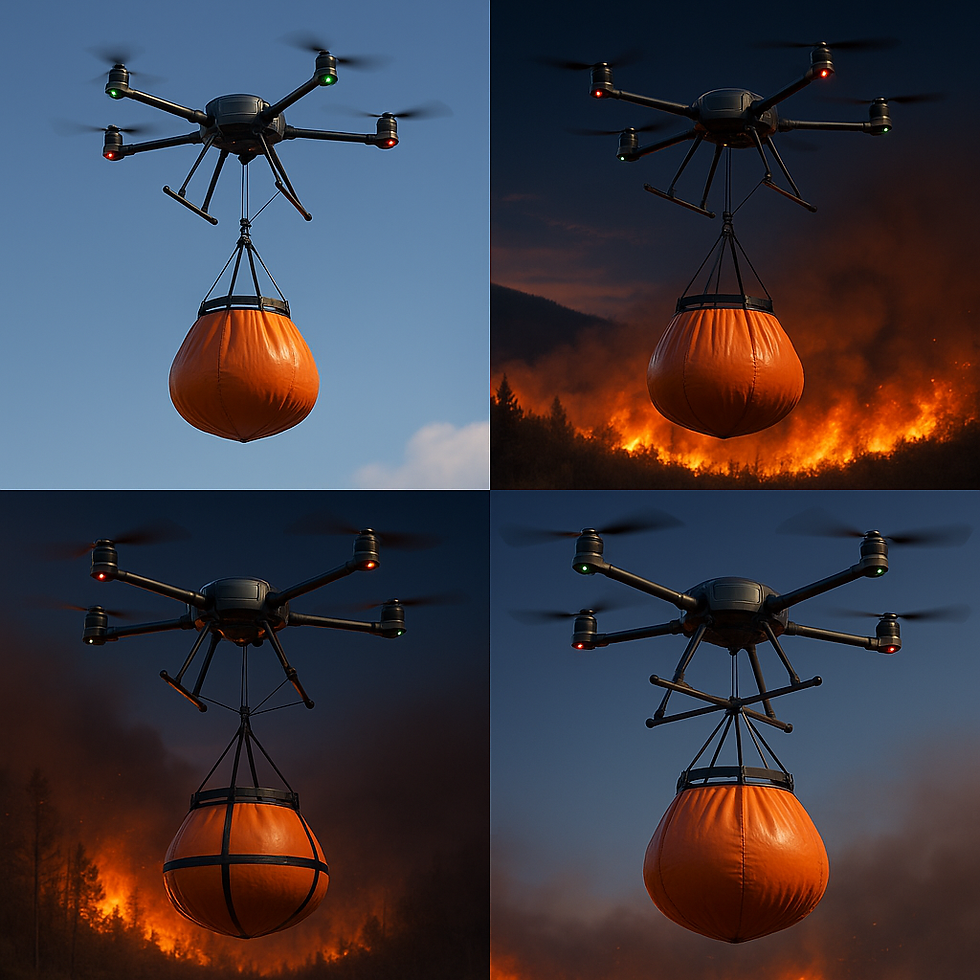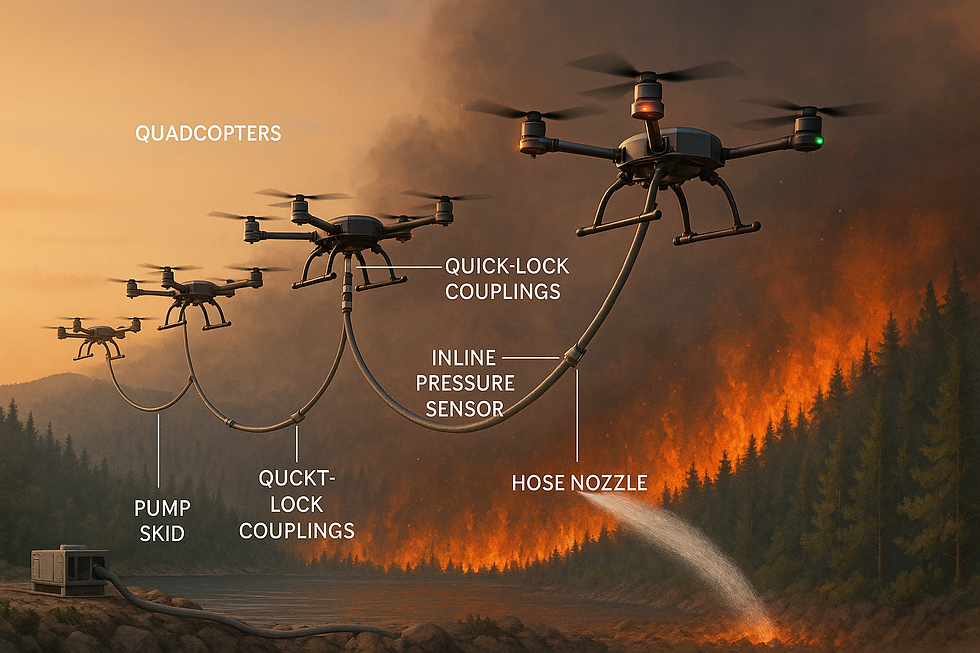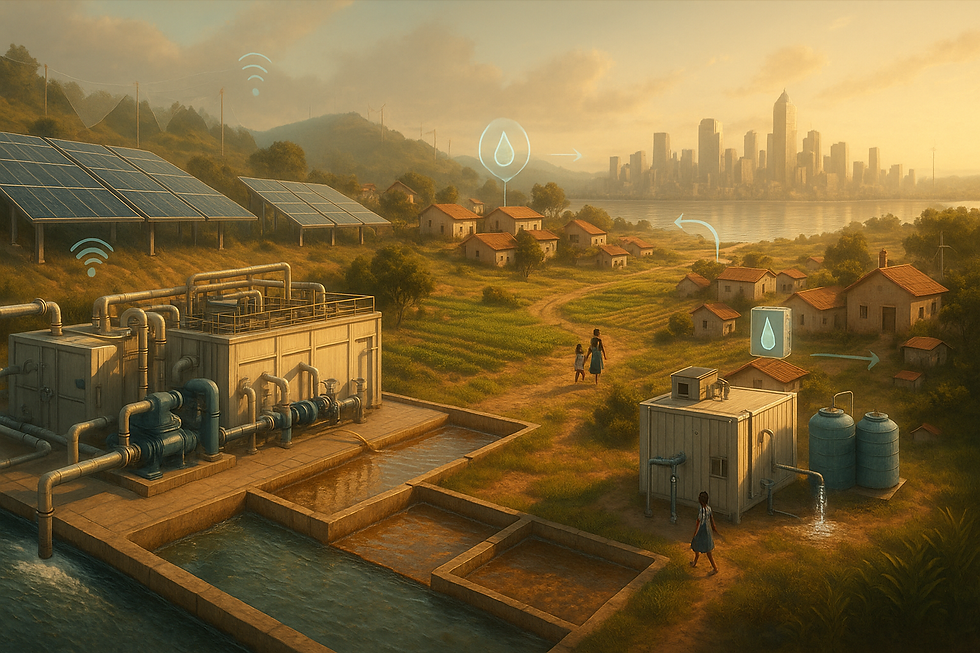Wildfire Drones - Imagine it
- David B. N. J. & "A.I."
- Aug 7
- 8 min read
Updated: Aug 21

Listen to an A.I. podcast version here:
And another podcast version here:
Download the paper at the bottom of this page.
Wildfire-Drone Technology Briefing Document
Introduction
This document summarises key themes, concepts, and technological innovations presented in the "Wildfire-Drone White Paper – by David B. N. J. & ChatGPT o3". The white paper outlines a comprehensive vision for autonomous wildfire response, encompassing reconnaissance, analytics, direct suppression, and logistics, leveraging drone technology.
Core Themes
1. Autonomous Reconnaissance and Intelligence Gathering
The white paper heavily emphasises the use of drone swarms for real-time, comprehensive situational awareness.
Swarm-based Operations: "Autonomous Reconnaissance Swarm – mission overview" describes "four hexacopters cruising at staggered altitudes" providing a "semi-transparent thermal overlay reveals hot-spots below". These swarms utilise "Self-healing mesh logic" and "Edge AI load-balancing" for robust communication and data processing, with "packets routed with OLSR, latency < 120 ms."
Advanced Sensor Suites: Individual drones are equipped with "Multi-Spectral Sensor Suite[s]" including a "Visible-light 48 MP sensor", "Boson 640 IR core" for thermal imaging, and "32-line solid-state LiDAR" for 3D mapping and obstacle avoidance. These are mounted on "3-axis micro-gimbal[s]" for stability.
On-board AI for Prediction: Drones integrate "On-Board AI Fire-Spread Prediction" using "CNN inference heat-map[s]" to show "AI-predicted spread vectors (arrows) 10 min ahead". This inference runs locally on "Jetson Orin NX at 40 TOPS" with "predictions updated every 15 s, RMS error ±35 m," providing immediate foresight to ground crews.
2. Diverse Suppression Capabilities
The white paper details a wide array of drone-based suppression methods, moving beyond traditional water drops.
Fire-Retardant Application: "Fire-Retardant Micro-Dispenser Module[s]" on octocopters can spray "a conical mist of ammonium-polyphosphate micro-droplets onto brush" from a "22 L composite tank" with a "Variable-geometry nozzle".
Controlled Ignition (Prescribed Burns): "Ignition Sphere (“Dragon Egg”) Payload Drone[s]" are designed to drop "red plastic spheres along a bulldozed line, small flames igniting seconds later." These drones feature a "300-ball hopper" and "CO₂-needle injector" for precise, controlled burns.
Novel Water Delivery Systems:
Aerial Hose Lines: "Multi-Drone Aerial Hose Line[s]" show "five medium quad-rotors...slung under a single 75 mm Kevlar-reinforced hose" capable of delivering "450 L min⁻¹ at 10 bar."
Heavy-Lift Bombing: "Heavy-Lift Water Bomber[s]" are large coaxial-rotor UAVs (7 m span) capable of releasing a "400 kg belly tank" in "5 s empty time."
Amphibious Refill: "Amphibious “Scoop-&-Go” Drone[s]" can "skim surface, twin retractable scoops channel water into a 120 L dorsal bladder" in "under eight seconds."
Water-Bag Swarms: "Water-Bag Shuttle Swarm[s]" consist of "six small hexacopters" each carrying "30 L collapsible bags that detach on target", capable of sustaining "600 L min⁻¹ flow."
Targeted Suppression: "Drone-Mounted Impulse Cannon[s]" can launch "10 L gel-pack projectiles" into crown fires "60 m away", and "Water-Curtain “Shield Wall”[s]" use "Two rows of micro-drones" emitting "overlapping mist sheets that cool an approaching flame front."
Sling-Load Systems: A "Quad-Lift Sling-Bag Drop System" is presented, where "Four medium-lift quadcopters fly in a cruciform pattern, each connected to a corner of a quick-release harness that supports a 400 L flexible water bag." This system achieves "helicopter-class drop volumes" without traditional aircraft risks.
3. Robust Communication and Control
A strong emphasis is placed on maintaining seamless data flow and command capabilities in challenging environments.
Mesh Networking: "Swarm-Networking Topology" diagrams illustrate "ten drones as nodes over stylised terrain; links pulse in real time toward a mobile command truck." Each airframe has "LoRa & 5-GHz Wi-Fi mesh radios embedded in arm tips" and "beam-steering patch array" antennas.
Tethered Relays: "Tethered Communication Relay[s]" use a "quadcopter tethered to a ground spool" with a "200 m Kevlar-silicone tether" providing "8 kW continuous power" and acting as a "High-gain Ka-band dish" for satellite backhaul. This ensures connectivity "even when smoke blocks line-of-sight radio."
Augmented Reality Interface: "Augmented-Reality Command Interface[s]" allow "Ground crew wearing AR visor[s]" to see "holographic drones, fire perimeters, and voice command prompts," providing "Real-time telemetry" and "Colour-coded risk zones."
4. Logistics and Maintenance
The white paper addresses the practical aspects of sustaining drone operations in the field.
Mobile Recharging: "Mobile Field Recharging & Service Hub[s]" are "Electric 4×4 truck[s]" that "unfold two induction “perch pads”" for autonomous landing and feature a "Vision-guided swap arm" to "swaps battery packs."
Rapid Maintenance: "Rapid-Maintenance Modular Arm Swap[s]" allow technicians to quickly replace damaged drone components using "Tool-less quick-release joint[s]" and "magnetic pogo pins," ensuring a drone can be "mission-critical airframe in under two minutes—no bench time, no solder, just swap and fly."
Mobile Refill Systems: An "8 000-litre all-terrain tanker" serves as a "Rolling Refill Truck & Drone Dock" with a "tank-top docking ring" and "Peristaltic fast-fill (200 L min⁻¹)" robotic arm to refill drone bladders "while truck cruises at 15 km h⁻¹."
Key Technological Innovations and Facts
Drone Hardware: Carbon-fibre frames with ceramic heat-shield skins, NVIDIA Jetson onboard, IP67 sealed gimbals, braided Teflon wiring rated ≥ 200 °C, Kevlar-reinforced bladders, Ultem hoppers, and UL94 V-0 casing for Li-ion packs.
Software and AI: AI path-planning, Edge AI load-balancing, CNN inference for fire spread prediction (40 TOPS), and swarm AI for staggered sortie scheduling.
Communication: LoRa & 5-GHz Wi-Fi mesh radios, OLSR routing, Ka-band dish for sat-backhaul, LTE-C-V2X link, and Ultra-wideband ranging for precise inter-drone spacing (±2 cm).
Power and Logistics: 8 kW continuous power via tether, 30 kW induction coils for charging, 12S Li-ion packs, and ground generators (60 kW) with Starlink backhaul on refill trucks.
Suppression Specifics:
Ammonium-polyphosphate micro-droplets for retardant.
CO₂-needle injector for "Dragon Egg" ignition spheres.
MARK-3-equivalent pump (450 L min⁻¹) for hose lines.
F50-LS-style drone for high-rise tethered sprayer (100 kg payload).
Thunder Wasp prototype frame for heavy-lift bomber (400 kg belly tank).
Biodegradable PA/EVOH/LLDPE water bag film.
Hydro-gel spheres for impulse cannons.
Kevlar-core rope (1.5 kN static) for winch tankers.
Efficiency Metrics: Packet latency < 120 ms, AI prediction updates every 15 s (RMS error ±35 m), 120 L scoop-and-go refill in < 8 s, 600 L/min water bag swarm flow, < 2 min for arm swap, < 10 s for bladder refill on mobile truck, and 400 kg sling-bag drop in < 0.8 s, cycle time ≈ 3-4 min.
Conclusion
The "Wildfire-Drone White Paper" presents a compelling and detailed vision for the future of wildfire management, portraying drones as an indispensable tool across all phases of response – from initial detection and predictive analytics to diverse and dynamic suppression strategies, underpinned by robust communication, mobile logistics, and rapid field maintenance. The concepts are grounded in plausible 2025-era technology, suggesting a near-future reality for autonomous wildfire response.

Another summary:
The challenge. Wildfires are growing larger, faster and more unpredictable due to climate change, expanded wild‑land/urban interfaces, and strained fire‑service resources.
The concept. This project proposes a fleet of autonomous, modular drones to detect, analyse and suppress wildfires—rapidly and without risking human crews. The system pairs AI‑driven reconnaissance platforms with water‑delivery and retardant drones, all tied together by a robust mesh‑network and mobile ground hubs.
Key objectives
Early detection: Deploy thermal‑imaging scout drones minutes after a lightning strike or sensor alarm.
Data‑driven decisions: Generate live fire‑spread predictions onboard the aircraft, feeding situational intelligence directly to incident command.
Agile suppression: Use a mix of micro‑mist, bucket‑drop, hose‑line and impulse‑cannon drones to extinguish flames or build containment lines—day or night, in terrain inaccessible to crewed aircraft.
Crew safety & emissions: Keep firefighters out of harm’s way and cut the carbon footprint relative to helicopters or air tankers.
System Architecture (Illustration References 1‑20)
Multi‑spectral Reconnaissance Swarm (Figs 1‑3). Hexacopters with visible‑light, FLIR and solid‑state LiDAR map the fire perimeter; an AI model running on‑board Jetson Orin NX hardware predicts spread 5–10 minutes ahead.
Suppression Payloads (Figs 4‑8, 11‑17).
Micro‑mist octocopter disperses 22 L of retardant from a gimbal‑stabilised nozzle (Fig 4).
Dragon‑Egg ignition drone seeds back‑burns with CO₂‑activated spheres (Fig 5).
Water‑delivery portfolio
Hose‑line trains (Fig 11)
High‑rise tether sprayer (Fig 12)
Heavy‑lift water bomber (Fig 13)
Amphibious scoop‑and‑go quad (Fig 14)
Shuttle‑swarm bag drops & curtain drones (Figs 15‑17)
Tandem‑rotor bucket tanker for canyons (Fig 18)
Rolling truck dock & last‑mile hybrid system (Figs 19‑20)
Networking & Logistics (Figs 6‑7). A tethered Ka‑band relay keeps comms alive in dense smoke, while an electric 4×4 service hub swaps batteries and payloads on the fly.
Operational Workflow & Benefits
Mission timeline
Launch & detect (T + 0–5 min). Scout swarm launches from trailer; thermal anomalies confirm ignition.
Analyse & plan (T + 5–10 min). On‑board AI generates spread vectors; incident command reviews AR overlays (Fig 9).
Initial attack (T + 10–20 min). Impulse‑cannon, micro‑mist and shuttle drones hit spot fires; ignition drones create defensive back‑burns if needed.
Sustained suppression (T + 20 min → hrs). Hose‑line, bomber and bucket systems deliver bulk water; truck hub and hybrid reservoirs enable continuous cycles.
Demobilise & recharge. Drones return for automated inspection; modular arms or battery packs are replaced in < 2 min (Fig 10).
Advantages over conventional assets
Speed: In‑field launch cuts response from hours to minutes.
Precision: Sub‑metre targeting minimises water waste and collateral damage.
Safety: Removes pilots and crew from low‑visibility, high‑turbulence zones.
Cost: Battery‑electric sorties cost a fraction of helicopter flight‑hours.
Scalability: Fleet size and payload mix can be tailored to incident size—from a single scout drone up to a multi‑company swarm.
Roadmap
2025–26: Prototype flight‑tests; regulatory engagement; controlled‑burn demos.
2027: Pilot deployments with selected fire agencies; refine AI models.
2028+: Full commercial roll‑out; cross‑border mutual‑aid capability; integration into national incident‑command systems.
Outcome: A flexible, autonomous airborne toolkit that transforms wildfire response—making it faster, safer and smarter.

"Firefighting, Re‑imagined from the Sky"
What if the very first responder to a forest fire wasn’t a truck grinding up a dirt road or a helicopter struggling through smoke, but a whisper‑quiet swarm of robots that can see through haze, think for themselves, and drop precision payloads before a single tree turns to ash? That question launched the Wildfire Drone Project—and the white paper you’ll find attached is the engineering answer.
Why we need a new playbook
Wildfires are no longer “once‑in‑a‑season.” They rage year‑round, fueled by hotter drought cycles and expanding wild‑land suburbs. Traditional assets—tankers, helos, hand crews—remain invaluable, yet they struggle with three hard limits: speed, access and risk. A battery‑electric drone, by contrast, can be wheels‑up in 90 seconds, fly through zero‑visibility smoke that would ground a pilot, and hit slopes too steep for a bulldozer. Multiply that by dozens of airframes working in concert and you rewrite the response curve.
Hardware that works like software
Think of the fleet as a modular app store in the sky:
Recon Scouts (Figs 1‑3) map the fire in real time, running AI models that forecast where it will be in five or ten minutes.
Suppression Specialists drop micro‑mist, gel spheres or 400‑litre sling bags with meter‑level accuracy—night or day.
Logistics Nodes—tethered comm relays and induction‑charging trucks—turn any fire road into a pop‑up airbase.
Because every drone shares the same mesh network and battery form‑factor, you can hot‑swap payloads as the fire evolves—from attack to containment to mop‑up—without returning to headquarters.
Safer for crews, kinder to the planet
Removing pilots from the cockpit doesn’t just save lives; it also slashes the carbon cost of suppression. A single heavy‑lift helicopter burns roughly 400 litres of Jet‑A per hour. Our entire drone stack, running on renewables, draws less energy than a city bus route—and it can be recharged by the solar arrays on its own service truck.
Economies of swarm scale
The beauty of distributed robotics is that capability scales linearly with budget. A cash‑strapped rural district might start with a three‑drone scout cell and a pickup‑mounted charger; a national agency could field a hundred‑strong fleet that behaves like a single organism, carving water‑curtains kilometres long.
A roadmap grounded in reality—not hype
We’re already flight‑testing prototypes over controlled burns and negotiating BVLOS waivers with regulators. Next year’s milestones include:
Autonomous drop certification in mixed‑airspace environments.
Edge‑stack AI upgrades that cut model latency below 50 ms.
Inter‑agency data hooks so fire crews can pull drone telemetry straight into existing command dashboards.
Dig deeper
The attached PDF breaks down every subsystem, from the ceramic heat‑shields on the scout gimbals to the quick‑dump valves in the 400 kg sling bag. It pairs each engineering concept with a photo‑realistic illustration so you can see exactly how the system works.
If you’re a firefighter, policymaker, investor—or just someone who loves forests—dive in. Because the sooner we put smart, fast robots in the plume, the sooner we tame the megafires of the 21st century.
Download the full white paper to explore schematics, specs and deployment scenarios in detail. Then imagine a world where the sound you hear above a new ignition isn’t a siren in the distance, but the whir of the first robotic responders already on station.
Download the main paper here:
Download some briefing documents and research reports here:





Comments